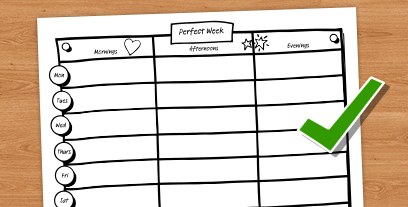Top Tips
Here are some important top tips for using the perfect week tool.

Don’t just document the current situation

Don’t just describe what the person is doing now – think about what they want to be doing in the near future.
Don’t use it as a strict timetable

Remember, the perfect week is a guide to what a person wants to do – it’s not a rigid timetable or activity plan.
Do state what’s fixed and what’s flexible

There are some things in a person’s life that they will consider as fixed, such as visits from relatives or social events, and other things that are flexible. Make sure that you are clear about what’s fixed and what’s flexible from the person’s perspective.
It’s important to get the balance right between having enough structure so that the right people are available to provide support and being flexible so that plans can adapt.
Do make it detailed

The perfect week should include clear, day-by-day information (am/pm/eve) about exactly what the person wants to do and who they want to support them.
Don’t use generic statements such as “morning routine” – what does this mean, what and who are involved?
Do make it realistic

Make sure that the activities that you record on the perfect week are realistic and within the budget and resources available.
Describe things that could really happen, not just what would be “wonderful if only it were possible.”
Do keep it up to date

Make sure that you review and update the perfect week on a regular basis as a person’s interests develop or the opportunities available to them change.
You may find that the perfect week might actually end up as the perfect month. It may also change between seasons.
Do keep the one-page profile up to date

A person’s up-to-date one page profile should reflect their perfect week. Compare these person-centered tools and check that this is the case.